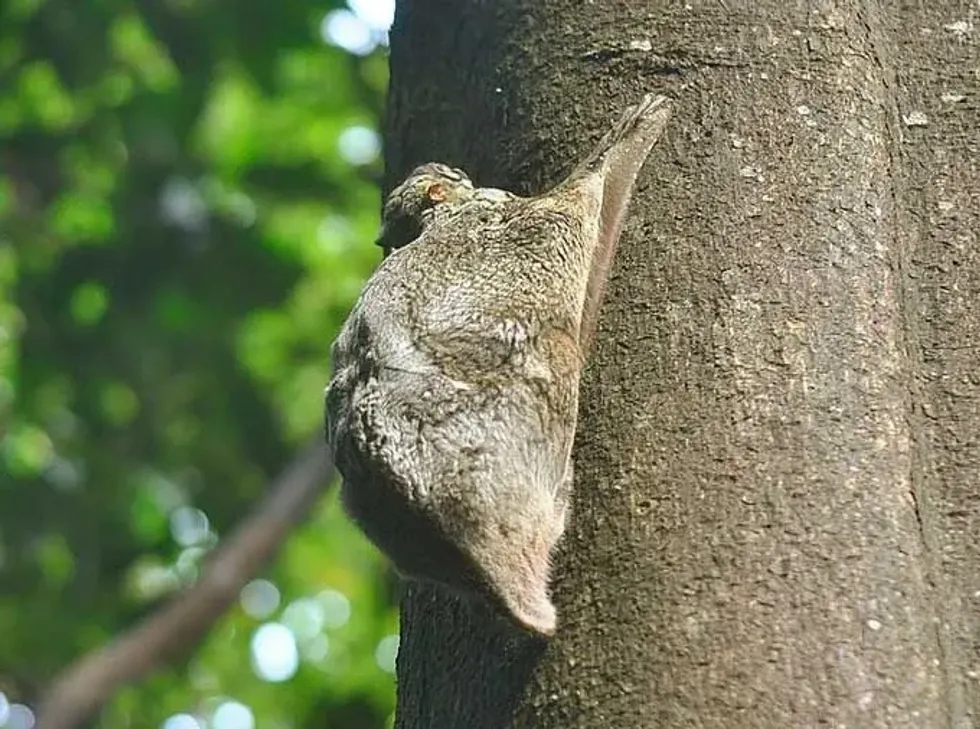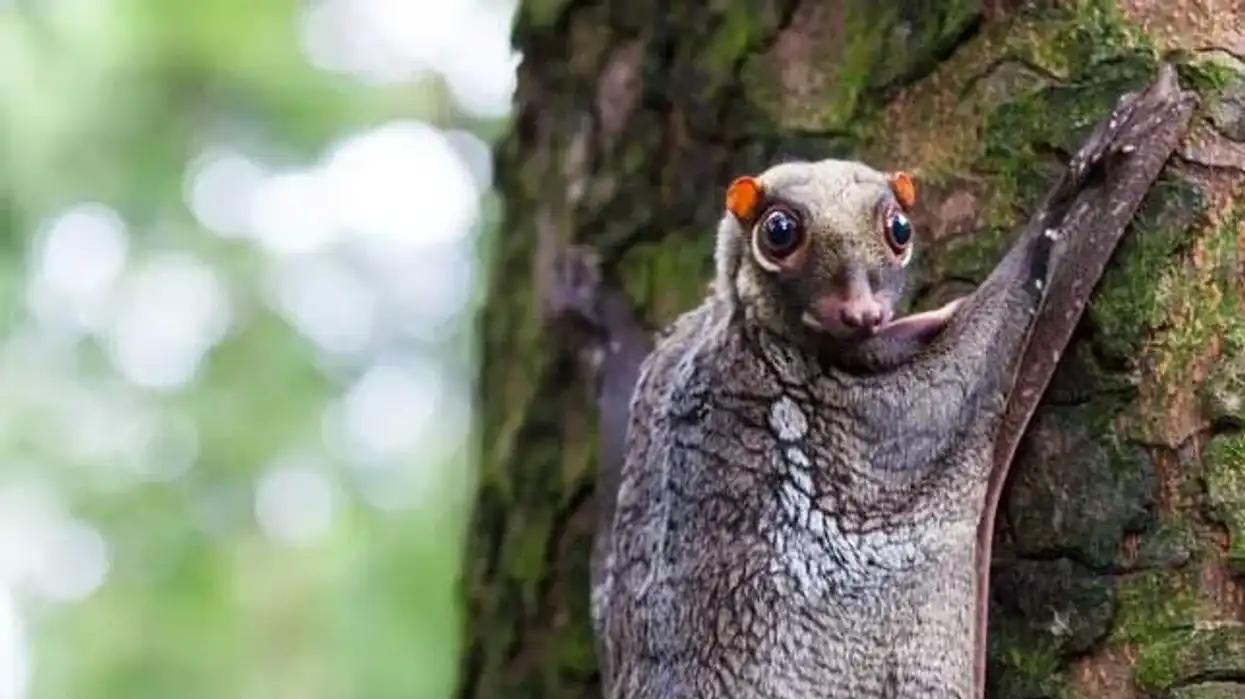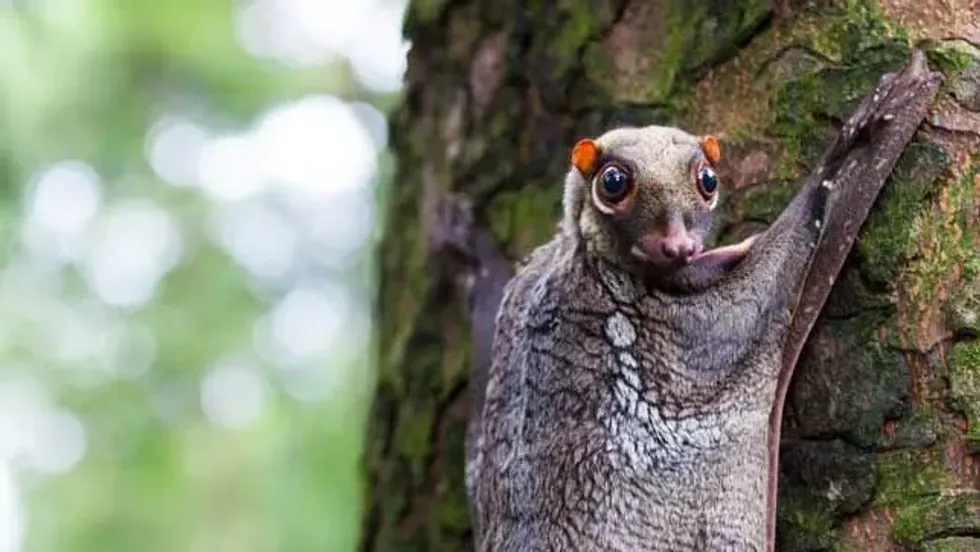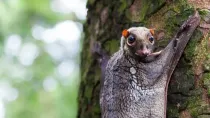Fun Sunda Colugo Facts For Kids

Sunda colugo (Galeopterus variegatus), also known as Sunda flying lemur or Malayan colugo or Malayan flying lemur, is of the Cynocephalidae family. These mainly nocturnal species can be found across Southeast Asia.
There are two species types of the Sunda colugo: dwarf and large lemurs. The dwarf flying lemur occupies central Laos and other islands, and the large occupy the Sunda shelf and Southeast Asia mainland area.
There are four known subspecies G. v. temminckii (Sumatra), G. v. borneanus (Borneo), G. v. variegatus (Java), and G. v. peninsulae (Peninsular Malaysia). However, recent morphological and molecular available data shows that Bornean, mainland, and Javan flying lemur subspecies can be considered as three different species under the Galeopterus genus.
Lemurs are found in white, black, gray, and sometimes in red color. Few synonyms of the family Cynocephalidae are Galeopithecidae, Colugidae, and Galeopteridae.
The population of these lemurs is threatened by habitat loss, hunting, and predation. The Sunda flying lemurs do not fly but only glide when they leap among the trees.
If the Sunda flying lemur facts were interesting, you can also check out amazing facts about the ring-tailed lemur and the slender loris on Kidadl.
Sunda Colugo Interesting Facts
What type of animal is a Sunda colugo?
Sunda colugo or Sunda flying lemur (Galeopterus variegatus) is a lemur species of the order Dermoptera, family Cynocephalidae, and phylum Chordata. These lemurs are strictly arboreal; that is, they live only on trees.
These tree animals are also mainly nocturnal. They sleep in the day in holes in trees.
While climbing a tree, they bring up the back legs and stretch out the front ones, which looks like awkward hopping. When threatened by predators, they either stop moving or climb higher into the dense foliage of the trees. They don't fly but take glides at an elevation of more than 328 ft (100 m).
The short glides lead to a high landing force, and longer glides lead to soft landings because they can break their glide. The Sunda colugo behavior is territorial, about the foraging (tree canopies) and sleeping range of habitats.
What class of animal does a Sunda colugo belong to?
Sunda colugo or Sunda flying lemur (Galeopterus variegatus) belongs to the Mammal class and genus Galeopterus of animals.
How many Sunda colugos are there in the world?
The current population of Sunda colugo or Sunda flying lemur (Galeopterus variegatus) is not known. However, the Encyclopedia of life's estimated population count is about 1,000. Even though this animal is listed as Least Concern by the IUCN Red List of Threatened Species, the population is decreasing due to the loss of habitat.
Where does a Sunda colugo live?
Sunda colugo or Malayan flying lemur range of habitat extends to a wide region in Southeast Asia. This range spreads across the Sunda Shelf mainland and islands like Vietnam, Northern Laos, Cambodia, Brunei, Thailand, Indonesia, Singapore, Malaysia, and many more islands. The relatives of this animal, the Philippines flying lemurs, range only across the southern regions of the Philippines.
What is a Sunda colugo's habitat?
Malaysian flying lemur or Sunda colugo habitat range includes primary and secondary forests, coconut and rubber plantations, lowlands, lowland dipterocarp forests, fruit orchards, mangrove swamps, gardens, treetops, upland forests, edges of forests, highlands, and mountainous regions.
They are known to adapt very well to these regions, and not many of this range of habitats can hold a large population of flying lemurs or colugos.
Who do Sunda colugos live with?
Sunda flying lemur is a strictly arboreal species, and they live on their own. However, there have been sightings of a small group of these flying lemurs.
How long does a Sunda colugo live?
Sunda flying lemur lifespan is around 17.5 years in captivity. The life expectancy of the Sunda flung lemurs in the wild is not yet known.
How do they reproduce?
There is only a little information about courtship and the reproductive cycle. Sunda flying lemur can mate all through the year. The gestation period lasts for 60 days.
The female produces a single offspring after the gestation period. They rarely produce twins. The single offspring is produced at an underdeveloped stage.
They wean at six months, and at three years, they reach adulthood. Females mate again right after giving birth and also get pregnant while nursing her young.
The young Sunda colugo nurse from the mother's mammae near her armpits. To keep her young warm and protect them, the female can fold her patagium in the form of a pouch. When the mother glides from tree to tree, the young ones cling on to their underside.
What is their conservation status?
The Sunda flying lemur population is listed as Least Concern by the IUCN Red List of Threatened Species. The population of this animal is under serious threat due to the loss of habitat and hunting for their meat and fur.
Sunda Colugo Fun Facts
What do Sunda colugos look like?
Sunda flying lemur (species Galeopterus variegatus) is a strictly arboreal species. This animal has large forward-facing eyes, wide brows, a small head, a blunt snout, and small ears. Sunda flying lemur has a mottled and dense fur.
This animal has pale underparts and gray, black, red, or white dorsal fur. They have bold color patches which allow them to camouflage. They have a gliding skin membrane called a patagium.
The patagium extends to the limbs from the neck to their fingers, tail, and toes. An extensor muscle present in the flank membranes helps the patagium to extend up to 27.5 in (70 cm). These flying lemurs have four legs with curled claws and webbed feet.
They get a better grip due to the sucking disc form of their soles. These flying lemurs have 34 teeth. They have distinct bottom incisors, which are comb-shaped.
There are 20 prongs per tooth in the incisors. The canine of the Sunda flying lemurs is identical to premolars. Unlike most mammals with single-rooted incisors, the Sunda flying lemurs have double-rooted second incisors.

How cute are they?
Sunda flying lemur (species Galeopterus variegatus) is small tree species with large eyes. So, they are considered cute.
How do they communicate?
Sunda flying lemur is a solitary animal and is territorial of foraging and sleeping regions. There is very little information regarding the communication between species of flying lemurs. They usually communicate through vocalization, visualization, and chemical release.
How big is a Sunda colugo?
The head-to-body length of the Sunda flying lemur is 13-17 in (33-42 cm), and tail length is 7.1-10.6 in (18-27 cm).
How fast can a Sunda colugo move?
The exact speed of the Sunda flying lemur is not yet known.
How much does a Sunda colugo weigh?
Sunda flying lemur or Sunda colugo weight is around 2-2.9 lb (0.9-1.3 kg). The baby Sunda colugo is 0.07 lb (35 g) in weight.
What are the male and female names of the species?
There is no specific name given to the female and male Sunda flying lemurs.
What would you call a baby Sunda colugo?
There is no specific name given to the baby Sunda flying lemurs. They are referred to as offsprings or baby Sunda colugo.
What do they eat?
The Sunda colugo sleeps in dense foliage in the day in tree holes and eats at night. Malayan flying lemur or Sunda colugo diet consists of soft plant parts, insects, flowers, fruits, young leaves, shoots, and buds.
The leaves in their diet normally have less nitrogen and potassium compounds. They also forage the tree canopies and licking tree bark for salts, water, minerals, and nutrients. They also feed on sap, durian flowers, and coconut flowers.
Are they aggressive?
The Sunda colugo lemur or Malayan colugo is not very aggressive. However, they are territorial species. They can vote human beings, but there are not many records on such incidents.
Would they make a good pet?
No, Sunda flying lemurs would not make a good pet. This tree species does very well on trees in a large region.
Did you know...
Some predators of the Sunda flying lemurs include hawks, eagles like the Philippine eagles, other birds of prey, and snakes.
One positive impact of the Sunda flying lemurs includes seed dispersal and flower pollination as they consume flowers and fruits.
Another flying lemur in this entire family is the Philippine flying lemur. These two species are the most capable known gliders of all the other gliders.
Philippine flying lemur also has similar mechanisms like they glide instead of flying and are quite helpless on the forest floor.
Although Sunda flying lemurs climb higher into trees when they come across predators. Their easy access to scattered food sources due to their ability to glide does not expose them to their predators a lot. These Sunda flying lemurs can also easily camouflage against predators due to the lichen effect provided by the bold patches of their fur.
The presence of the gliding membrane, patagium of the Sunda flying lemurs makes them better gliders than bats, flying squirrels, and sugar gliders.
The highest recorded elevation of flight of these flying lemurs is 446 ft (136 m).
Sunda flying lemurs can hang comfortably from a branch as they are sitting on the branch.
Sunda flying lemurs were either previously linked to or classified as bats, primates, and insectivores.
Sunda flying lemurs have binocular vision, which enables them to focus with great eyesight. They need eyesight to escape the predators.
Few other gliding or flying animals are gliding ants, gliding fish, Chinese gliding frogs, flying squirrels, and flying paradise tree snakes.
It is challenging to look after these flying lemurs and breed them in captivity.
Colugos are not lemurs. They are related to both tree shrews and primates. They have one of the largest patagium membranes among the other gliding mammals.
Do Colugos fly?
Sunda flying lemurs do not fly but glide from one tree to another. While climbing a tree, they bring up the back legs and stretch out the front ones, which looks like awkward hopping. The short glides lead to a high landing force, and longer glides lead to soft landings because they can break their glide.
Can a flying lemur swim?
The Sunda flying lemurs cannot swim, and they hardly walk on forest floors.
Here at Kidadl, we have carefully created lots of interesting family-friendly animal facts for everyone to discover! For more relatable content, check out these ring-tailed lemur facts and Howler monkey facts pages.
You can even occupy yourself at home by coloring in one of our free printable sunda colugo coloring pages.
We Want Your Photos!
More for You
See All
Bachelor of Engineering specializing in Aeronautical/Aerospace Technology, Master of Business Administration specializing in Management

Arpitha RajendraBachelor of Engineering specializing in Aeronautical/Aerospace Technology, Master of Business Administration specializing in Management
With a background in Aeronautical Engineering and practical experience in various technical areas, Arpitha is a valuable member of the Kidadl content writing team. She did her Bachelor's degree in Engineering, specializing in Aeronautical Engineering, at Nitte Meenakshi Institute of Technology in 2020. Arpitha has honed her skills through her work with leading companies in Bangalore, where she contributed to several noteworthy projects, including the development of high-performance aircraft using morphing technology and the analysis of crack propagation using Abaqus XFEM.
Bachelor of Arts specializing in English Literature, Masters of Art specializing in English and Communication Skills

Sonali RawatBachelor of Arts specializing in English Literature, Masters of Art specializing in English and Communication Skills
Sonali has a Bachelor's degree in English literature from Guru Gobind Singh Indraprastha University and is currently pursuing a Master's in English and Communication from Christ University. With considerable experience in writing about lifestyle topics, including travel and health, she has a passion for Japanese culture, especially fashion, and anime, and has written on the subject before. Sonali has event managed a creative-writing festival and coordinated a student magazine at her university. Her favorite authors are Toni Morrison and Anita Desai.
Disclaimer
1) Kidadl is independent and to make our service free to you the reader we are supported by advertising. We hope you love our recommendations for products and services! What we suggest is selected independently by the Kidadl team. If you purchase using the Buy Now button we may earn a small commission. This does not influence our choices. Prices are correct and items are available at the time the article was published but we cannot guarantee that on the time of reading. Please note that Kidadl is a participant in the Amazon Services LLC Associates Program, an affiliate advertising program designed to provide a means for sites to earn advertising fees by advertising and linking to Amazon. We also link to other websites, but are not responsible for their content.
2) At Kidadl, we strive to recommend the very best activities and events. We will always aim to give you accurate information at the date of publication - however, information does change, so it’s important you do your own research, double-check and make the decision that is right for your family. We recognise that not all activities and ideas are appropriate for all children and families or in all circumstances. Our recommended activities are based on age but these are a guide. We recommend that these ideas are used as inspiration, that ideas are undertaken with appropriate adult supervision, and that each adult uses their own discretion and knowledge of their children to consider the safety and suitability. Kidadl cannot accept liability for the execution of these ideas, and parental supervision is advised at all times, as safety is paramount. Anyone using the information provided by Kidadl does so at their own risk and we can not accept liability if things go wrong.
3) Because we are an educational resource, we have quotes and facts about a range of historical and modern figures. We do not endorse the actions of or rhetoric of all the people included in these collections, but we think they are important for growing minds to learn about under the guidance of parents or guardians.







